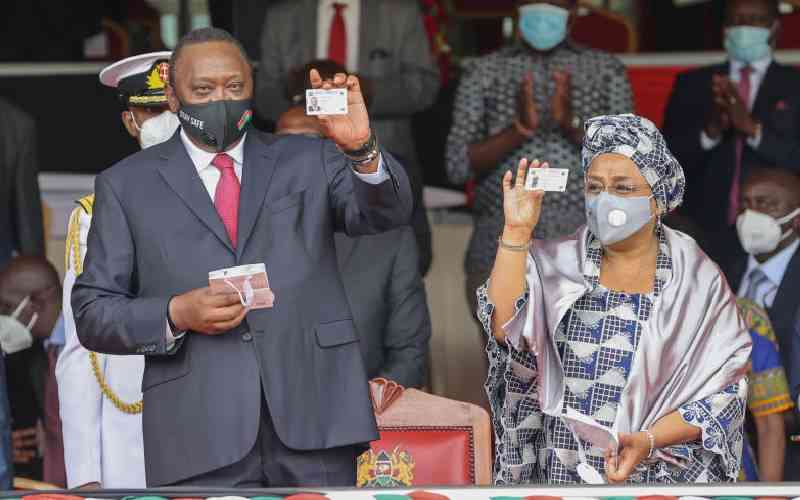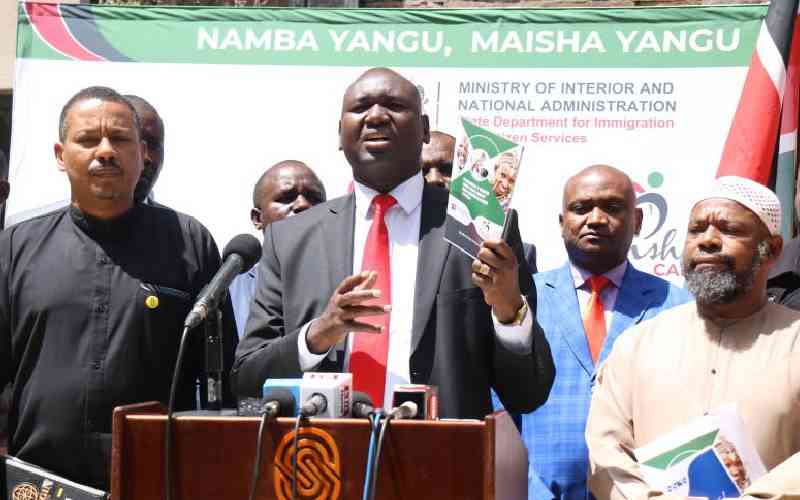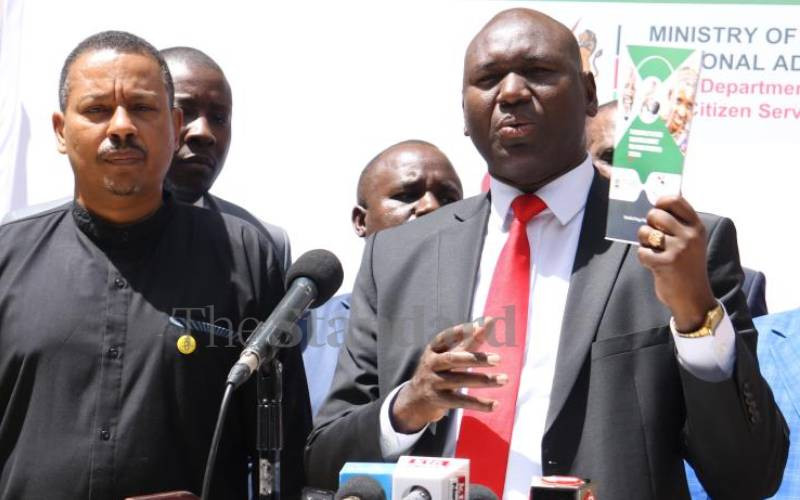
The big man signed off with a flourish and sat up. Everybody in his prestigious office smiled but still waited expectantly. The host frowned when he noted the expectant looks and the proffered ‘tablet’ with black ink.
The frown deepened when he learnt he had to affix his left thumbprint in a box at the corner of the form.
“Your excellency, this is the only signature God gave you. Your thumbprint has to be on the new identity card. The design is such that the new card will have your name and thumbprint. It cannot be forged by anybody,” Raphael Musau, who was driving the process, explained.
Satisfied with the explanation and notable and subtle security features embedded in the new document, President Daniel Moi, barely a year in office, placed his thumb on the wet surface and transferred his print (covered in black ink) on to the form. In a brief ceremony, Musau, who was the officer in charge of the National Registration Bureau, witnessed the handing over of the new generation national identity card to President Moi in 1977.
And with that Kenya replaced the hated identity card, Kipande, which had been used as an instrument of oppression and control of Kenyans by their colonial masters.
Forty two years later, Musau brushes off an array of ID cards from his mahogany table, grabs a card and matches towards a side table and thrusts it under the glare of purple florescent tube and triumphantly exclaims:
“This ID is fake. Do not let the smiling face of the woman whose picture appears here fool you. This has been made in River Road. Look at the top of the ID. Can you see anything near the Mt Kenya? There ought to be a security feature there,” he explains.
He then picks the magnifying glass next to his thick rimmed glasses and minutely examines the thumbprint on the ID card he has just dismissed as fake. He then compares its thumbprint from a sample printed on a piece of an A4 white paper and scribbles some numbers under some slots.
Unlike an old eagle, which is fabled to retreat to a mountain so that it can painfully pluck its feathers and knock off his beak and talons in the hope of growing a new set so that it can live another 30 years, Musau is not about to employ such antics.
Although he is 80, the hawk-eyed Musau has shifted his base from Nairobi’s CBD, his old haunts, to Yahya Centre. At least twice a week, he passes by Kipande House where he made his name in 1977 when he founded National Registration Bureau.
The great grandfather who is the managing director of a private firm, Hawk Eye Technologies Limited, is not yet tired of studying and classifying millions of whorls and loops of finger and palm prints of millions of Kenyans.
And although he laments that all his trainees at the CID headquarters have retired, he is determined to pass on his knowledge to others.
With the precision of a well maintained clock, every Monday afternoon at around 4pm he hops onto a bus at Yahya Centre and disembarks at Railways bus terminus and briskly walks to Aims College on Moi Avenue.
Here he trains young students in Forensic Investigations and specialises in fingerprint classification. He repeats the same process on Tuesdays before retreating to his base at Yahya Centre, the nerve centre of Hawk Eye Technologies where he consults as a private investigator.
Stay informed. Subscribe to our newsletter
His company, in business for the last 21 years, specialises in forensic and general fraud investigations, handwriting and fingerprint comparison, scene of crime investigation and photography, as well as security and survey audit.
His roots in fingerprint and forensic investigations go back to 1962 when Musau was recruited as soon as he cleared his secondary education at Kabaa High School to join three other youngsters trained in fingerprints identification for a few months.
After the training, the recruits were dispatched to CID headquarters (now known as Directorate of Criminal Investigations) to classify fingerprints collected from suspects.
Later in 1970, shortly after being gazetted as a fingerprintofficer he was sent to Scotland Yard Finger Prints Bureau where he learnt the science of fingerprints at the elite Detective Training School of Scene of Crime and was attached to the Glasgow Finger Print Bureau. In the meantime, as Europeans and Asians left the country, Musau got an opportunity to head the fingerprints section at the CID.
Colonial passbook
“In 1977, I was requested by then Vice President Daniel Moi to design a new Kenyan ID. This was to replace the blue colonial passbook, which had fingerprints but did not have the bearer’s portrait,” Musau recalls.
His first port of call, accompanied by Principal Registrar of Persons, was De La Rue Company in London where they took the new design.
Besides having the bearer’s picture, the new ID was also to be issued to women who were for the first time being granted the important document.
There had been a lot of resistance to this move as even senior government officials questioned the wisdom of documenting women who had been discriminated against by the colonial government.
The intrigues surrounding the issuance of the new national identity card were pale as compared to the controversies that dogged the introduction of this in 1917 and the trouble it caused both the government and Africans.
The issuance of ID in 1917 in East African Protectorate, as Kenya was called then, was done by the military in its bid to account for deserters after recruiting 120,000 porters to serve in the First World War.
At the time Kipande consisted of a sheaf of identification papers put in a metal disc, which was hang on the neck, and was supposed to help manage the ever ballooning wage bill.
Ironically, the Africans issued with Kipande attached little value to it and could lend the bothersome metal disc to their contemporaries to carry. Porters chose to draw salaries anywhere and had no means of identifying themselves. After the war, the government made the use of Kipande mandatory and was a condition for securing employment by Africans.
This sparked protests, which culminated in bloody riots of 1922 at Central Police Station, Nairobi, which were touched off by the arrest of Harry Thuku and a group of trade unionists.
The same restlessness greeted an attempt in 1948 by the government to issue a universal national identity card to all people living in the Kenya colony at the time.
Michael Blundell, a colonial settler who also served as an elected member of the Legislative Council representing Rift Valley, chronicles this in his memoirs, A Love Affair with the Sun: A Memoir of Seventy Years in Kenya.
Violent revolt
According to Blundell, there was a violent revolt among whites when they learnt they would be required to be fingerprintedjust like Africans and Asians.
In their mindset, fingerprints were a reserve for criminals or illiterate Africans and Asians but not the settlers who were the real owners and rulers of Kenya.
Blundell writes, “At first the idea of an ID card had been accepted by European voters but when it was suddenly realised that this meant fingerprinting for everyone a storm broke about our heads.
Europeans with conservative ideas immediately associated this with criminals”.
To demonstrate their anger, one civil society conducted a series of protest meetings during which they waved Britain’s national flag and sang God Save the King as a sign of their patriotism as they denounced the colonial government.
The metal disc has long been phased out and the first generation national ID card is no longer in vogue, but as Kenya does the piloting of the National Integrated IdentityManagement System (NIIMS) Huduma Namba in 15 counties, controversies still linger.
“The National Registration Bureau has more than 20 million fingerprints. All Kenyans aged above 18 have national IDs which have unique numbers. Why can’t we utilise this data?” wonders Musau.
And as the government strives to create a NIIMS for Kenyans, Musau is convinced that the current drive to establish a digital database with biometreics of an estimated 50 million people at a cost of Sh9 billion is an overkill.
“We have the national identity card, which has the thumbprint and a unique number. The government is just duplicating at a great cost what it already has. With fingerprints we should not have any unidentified or undocumented adults. Faces change but finger prints don’t long after one has died,” says Musau.
 The Standard Group Plc is a
multi-media organization with investments in media platforms spanning newspaper
print operations, television, radio broadcasting, digital and online services. The
Standard Group is recognized as a leading multi-media house in Kenya with a key
influence in matters of national and international interest.
The Standard Group Plc is a
multi-media organization with investments in media platforms spanning newspaper
print operations, television, radio broadcasting, digital and online services. The
Standard Group is recognized as a leading multi-media house in Kenya with a key
influence in matters of national and international interest.
 The Standard Group Plc is a
multi-media organization with investments in media platforms spanning newspaper
print operations, television, radio broadcasting, digital and online services. The
Standard Group is recognized as a leading multi-media house in Kenya with a key
influence in matters of national and international interest.
The Standard Group Plc is a
multi-media organization with investments in media platforms spanning newspaper
print operations, television, radio broadcasting, digital and online services. The
Standard Group is recognized as a leading multi-media house in Kenya with a key
influence in matters of national and international interest.









